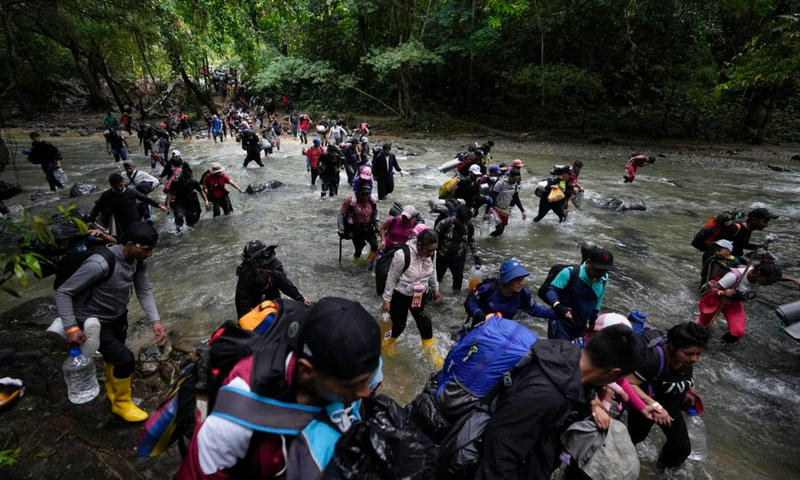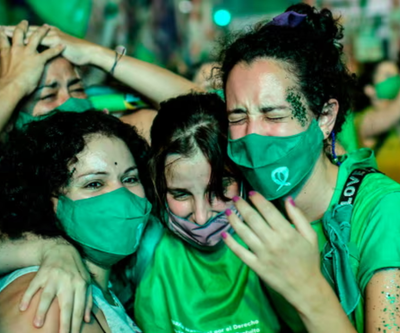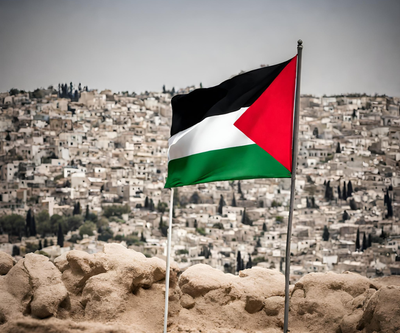The Darién Gap Panama has become one of the biggest and most dangerous migrational routes among undocumented migrants who decided to embark on their journey without legal documentation to the United States and to Canada and now for foreigners seeking a tourist thrill.
Imagine that you're immersed in a hike in the heart of the Panamanian jungle, marveling at the incredible diversity of animals and landscape surrounding you. Thanks to a guide who has extensive experience in the area you delve into an experience where both safety, security and resources are guaranteed. Your destination is the beautiful Pacific Coast beach. This extensive hiking tour will undoubtedly be etched in your memory.
However, just an hour away from where you are, hundreds of migrants face a completely different reality. Many of them choose to venture into the jungle not for thrill-seeking purposes but because they are fleeing the persecutions and hardships they faced in their home countries. Along the way, they battle hunger, thirst, wild animals, confront threats and violence from violent organized criminal groups. Despite the risks, these brave individuals attempt to cross the Darién Gap with hopes of reaching North America and finding a better future. The so-called “American Dream” or El Sueno Americano is one a migrant dreams of, but doesn’t realize they may never wake up when attempting to realize it.
According to the latest figures published by the Panamanian government, in the first half of 2023 over 200,000 people have crossed the jungle for migratory purposes. In comparison to 2021 it was reported 150,000 migrants crossed. Some humanitarian groups have estimated that in 2023 that number can double to 400,000 by the end of this year marking a possible 160% increase compared to 2021.
International organizations such as the United Nations (UN) put pressure on the Panamanian government and other governments this month for an urgent humanitarian intervention to stop further lives lost and atrocious violent acts against migrants in the Darién Gap. They are asking governments for more legal pathways to immigration.
In a statement released in July 2023, the Panamanian government stated that there is no connection between those who engage in tourism in the south Darién Gap area and those who traverse it for migration purposes in the northern part. Furthermore, they indicated that the Darién National Park covers 1.4 million acres, thus there is no relation between the two activities. In fact, they are separated by more than 55 miles, which equals 90 kilometers.
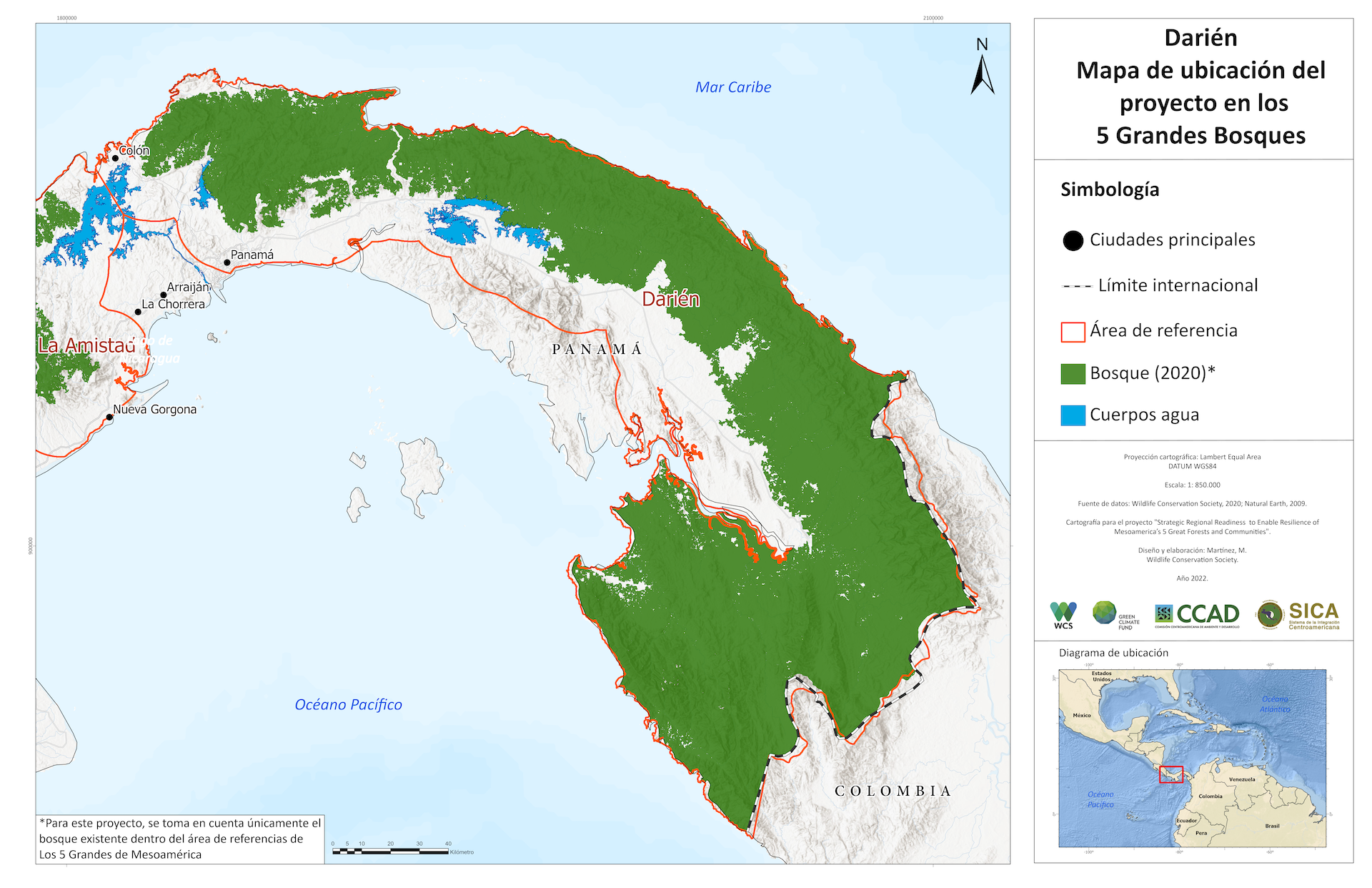
The Darién Jungle: A Life-Risking trek for Migrants and Challenging Route For Tourists
Those who decide to embark on the adventure for either tourism or migration purposes must traverse one of the most dangerous jungles in Central America and the Caribbean. Along the way, they may encounter wild animals such as snakes, pumas, alligators, spiders, harpy eagles, among others. This marshy and humid region is located on the border between Colombia and Panama. It is a remote and dense rainforest with swamps and no roads. It is commonly known as the "Darién Gap" because it interrupts the world's longest road network, known as the Pan-American Highway.
A German tourist company offers a two-week trek through the Pacific coast area of the Darién starting from December 2023 to February 2024. The camp will be composed of a group of 13 people guided by professionals, with Panamanian tour guides with over 20 years of experience in the area as mentioned on their website. The cost of the trip is 3,643 euros which is approximately 4,000 dollars per person, and the goal is to traverse the dense rainforest jungle until reaching a beach in the Pacific area.
On the other hand, migrants wishing to cross the Darién Gap do not pay a specific cost, but to initiate the trek it’s between $300 to $500 with the total cost averaging $5,000 to $10,000 by the time they get to the U.S. border. In the town of Acandi in Colombia, guides can be hired to help carry children and luggage, but this service only goes up to the Panamanian border. Some people bring much more money to buy food in the camps and cover other expenses that arise after leaving the jungle. There are also those who pay guides to orient them in the jungle, but this doesn't provide a safe crossing through the Darién Gap.
The Los Angeles Times interviewed a migrant named Rosmary who paid $3,000 in advance to cross with her family at a river known as 'Muerte River,' where the guide forced them to cross it. Her husband and young son died in the attempt. Rosmary saw the river swept them away; that's the last memory she has of them.
According to the UN’s International Organization for Migration (IMO) 36 migrants died last year attempting to traverse the Darién Gap. IMO reported those numbers are small but fear there are more that are never reported or are lost in the jungle.
Meanwhile the tourism company glamorized the trek on their website, describing it as “Our goal is to traverse what is probably the most infamous jungle in the world. Together we will make our way through vines, lianas and dense undergrowth for days until we finally reach the coast of the Pacific Ocean.” Despite the challenges posed by the route, this area tourist companies use is apparently not utilized by smugglers or criminals. Furthermore, the tourism company indicates that they avoid the direct border zone with Colombia and the eastern part of the Darién Gap, where migrants are exposed to the greatest dangers. The German company also points out that the Embera indigenous community supports them and are oftentimes guides.
The website reads “If everything works out, we'll reach a lonely beach on the Pacific coast of Panama after just under ten days. There we can recover from the exertions in the jungle under shady palm trees.” as if this was an extreme tourist dream vacation.
This is not the only company conducting this journey for tourism purposes. Other organizations also see an opportunity in this area to showcase the abundant biodiversity found in the Darién Gap.
On the other side of the Darién Gap, migrants' experiences are not for recreational extreme tourism purposes as foreigners 55 miles away seek. Each of them has a different story that has led them to make the difficult decision to leave everything behind and venture into the tropical jungle. Some physically and mentally prepare for the journey, meticulously studying the route before setting out. Meanwhile, others embark on the path with just the clothes on their backs, not truly knowing what awaits them. The resources available to migrants vary according to each individual's circumstances, ranging from less than $1,000, as in Pedro's case, who shared his story with the BBC, to around $10,000, as Daimaris explains. She crossed the jungle with her two young children and shared her experience on AmericaTeVe Miami, an independent Spanish-language television station based in Miami. However, on this journey, money cannot buy safety or prevent a non-traumatic experience.
Samira Gozaine, Director of Panama's National Migration Service, explained to CNN in 2023 that the majority of individuals who have crossed the Darién Gap so far this year are Haitians, Ecuadorians, and the majority Venezuelans. Nevertheless, they have also received people from other continents such as India, China, and Bangladesh.
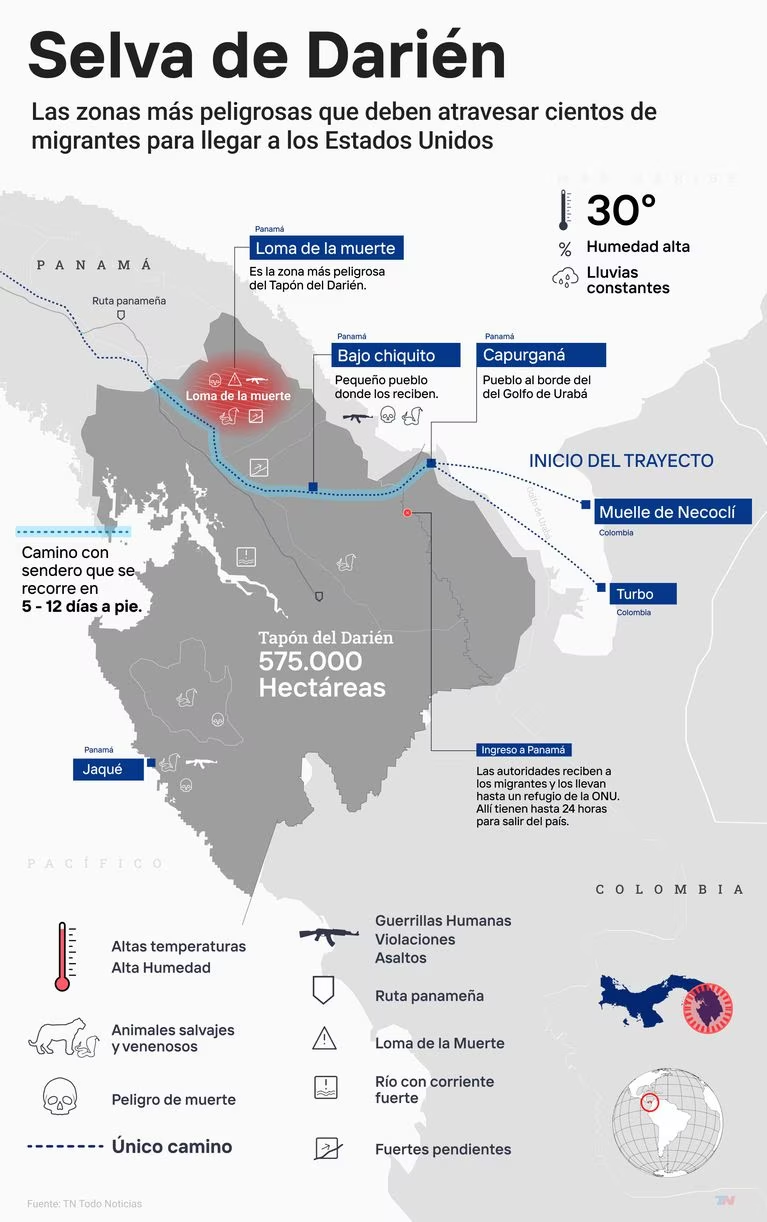
"Follow the River Path"
Those who choose to venture into the Darién Gap must spend between ten and fifteen days walking through unpaved, muddy and narrow paths. During the journey, they may encounter wild animals such as mountain pigs, jaguars, foxes, and wild dogs. There are also venomous creatures like snakes, scorpions, or spiders. Along the route and unlike the jungle’s tourist route, the bodies of people who have died for various reasons can be seen. Upon seeing them, migrants must keep moving because there's no time to stop.
Men, women, children, and the elderly—none are safe from the dangers of traversing the dense jungle. On the journey, they might encounter various armed groups that rob them of their belongings and threaten to kill them if they have any hidden valuables. Cases of rape, murder, and human trafficking are part of the journey.
For Andrés Farrat, a Venezuelan migrant who crossed the Darién Gap in October 2022 said the most important thing is mental strength because you don't know what will come next, you're not certain you'll make it out. BoldLatina is using his name with his consent and permission. Farrat describes the experience as overwhelming one wrong step could extend your stay and jeopardize your survival. As you progress, you go through various stages—initially, you can still turn back, but once you're deep in, you can only move forward; stopping increases the chances of dying.
"Once you're inside, if you can't keep walking, you probably won't make it out. If you fall, you might not survive," Farrat told BoldLatina.
Video footage credit: Andrés Farrat
The young Venezuelan recounts when he reached the border between Colombia and Panama, the guide instructed them to follow the river downstream, always follow the river, and they'd reach the end. Despite already walking for several days, the worst was just beginning. As directed, he and his group embarked on the journey alone, always following the river path. That's how they never got lost.
"Instinct helps you orient yourself in parts where you have to continue on land because you can't cross the river," Farrat explains.
Regarding the involvement of the Panamanian Government and its plans to assist and secure those crossing the Darién Gap, Andrés notes that when he crossed, there weren't many military personnel in the area helping. At one point, he saw a group with Colombian nationals arrested. He also encountered a camp where he met a security agent who told him to keep walking, but at no point did he feel they were going to help.
When the young man reached "Bajo Chiquito" he could see more security agents maintaining order. After four hours of navigating the river in a canoe, they reached the UN camp where there were more security agents.
For Andrés, it doesn't make sense to undertake the route for tourism purposes. He explains the jungle is extremely dangerous, and there are no guarantees that you'll make it out. In his case, the day he and his six companions reached the UN camp, President Biden announced the closure of the border for Venezuelans. At that moment, he felt a lot of uncertainty, didn't know what to do, but after discussing it, they decided to head to Costa Rica, where they spent two and a half months before being able to continue to the United States.
Currently, Farrat is in the United States, waiting to resolve his legal immigration path and seeking asylum. He entered using the CBP One application, which allows asylum-seeking migrants to present themselves at the U.S, border and legally enter.
These are the two sides of the coin faced daily by millions of people, both within and outside the United States. Though they tread the same path, each individual's experiences are uniquely based on socio-economic circumstances. It's not about whether any of them are right or wrong, rather, it's directly related to the circumstances each person faces and their desire for a dignified life or touristically promoting the beauty of the Darién Gap even if for others it means hardship. For thousands of people around the world, the Darién Gap represents an opportunity that could change their lives, even though most migrants agree it's much more dangerous than anticipated. Nevertheless, they hold onto hope that, upon reaching their final destination, they can leave behind all the pain they've encountered on their journey.

